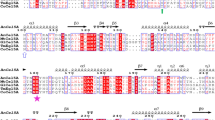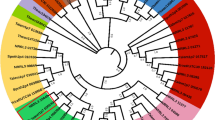Abstract
Humicola grisea var. thermoidea is a deuteromycete which secretes a large spectrum of hydrolytic enzymes when grown on lignocellulosic residues. This study focused on the heterologous expression and recombinant enzyme analysis of the major secreted cellulase when the fungus is grown on sugarcane bagasse as the sole carbon source. Cellobiohydrolase 1.2 (CBH 1.2) cDNA was cloned in Pichia pastoris under control of the AOX1 promoter. Recombinant protein (rCBH1.2) was efficiently produced and secreted as a functional enzyme, presenting a molecular mass of 47 kDa. Maximum enzyme production was achieved at 96 h, in culture medium supplemented with 1.34 % urea and 1 % yeast extract and upon induction with 1 % methanol. Recombinant enzyme exhibited optimum activity at 60 °C and pH 8, and presented a remarkable thermostability, particularly at alkaline pH. Activity was evaluated on different cellulosic substrates (carboxymethyl cellulose, filter paper, microcrystalline cellulose and 4-para-nitrophenyl β-d-glucopyranoside). Interestingly, rCBH1.2 presented both exoglucanase and endoglucanase activities and mechanical agitation increased substrate hydrolysis. Results indicate that rCBH1.2 is a potential biocatalyst for applications in the textile industry or detergent formulation.






Similar content being viewed by others
References
Akcapinar GB, Gul O, Sezerman U (2011) Effect of codon optimization on the expression of Trichoderma reesei endoglucanase 1 in Pichia pastoris. Biotecnol Prog 27:1257–1263
Azevedo MO, Felipe MSS, Astolfi-Filho S, Radford A (1990) Cloning, sequencing and homologies of the cbh-1 (exoglucanase) gene of Humicola grisea var. thermoidea. J Gen Microbiol 136:2569–2576
Baba Y, Shimonaka A, Koga G, Murashima K, Kubota H, Kono T (2005) Purification and characterization a new Endo-1,4-β-D-glucanase from Beltraniella portoricensis. Biosci Biotechnol Biochem 69:1198–1201
Bao L, Huang Q, Chang L, Zhou J, Lu H (2011) Screening and characterization of a cellulase with endocellulase and exocellulase activity from yak rumen metagenome. J Mol Catal B Enzym 73:104–110
Boisset C, Fraschini C, Schulein M, Henrissat B, Chanzy H (2000) Imaging the Enzymatic digestion of bacterial cellulose ribbons reveals the endo character of the cellobiohydrolase Cel6A from Humicola insolens and its mode of synergy with cellobiohydrolase Cel7A. Appl Environ Microbiol 66:1444–1452
Cavaco-Paulo A (1998) Mechanisms of cellulase action in textile processes. Carbohydr Polym 37:273–277
Cavaco-Paulo A, Almeida L, Bishop D (1996) Effects of agitation and endoglucanase pretreatment on the cotton fabrics by a total cellulase. Text Res J 66:287–294
Cavaco-Paulo A, Morgado J, Andreaus J, Kilburn D (1999) Interactions of cotton with CBD peptides. Enzyme Microb Technol 25:639–643
Chu CY, Tseng CW, Yueh PY, Duan CH, Liu JR (2011) Molecular cloning and characterization of a β-glucanase from Piromyces rhizinflatus. J Biosci Bioeng 111:541–546
De Paula EH, Ramos LP, Azevedo MO (1999) The potencial of Humicola grisea var. thermoidea for bioconversion of sugar cane bagasse. Bioresour Technol 68:35–41
De Paula EH, Poças-Fonseca MJ, Azevedo MO (2003) The product of Humicola grisea var. thermoidea cbh1.2 gene is the major protein under induction by lignocellulosic residues. World J Microbiol Biotechnol 19:631–635
Faria FP, Teo VSJ, Bergquist PL, Azevedo MO, Nevalainen KMH (2002) Expression and processing of a major xylanase (XYN2) from the thermophilic fungus Humicola grisea var. thermoidea in Trichoderma reesei. Lett Appl Microbiol 34:119–123
Ghose TK (1987) Measurement of cellulase activities. Pure Appl Chem 59:257–268
Gilkes NR, Henrissat B, Kilburn DG, Miller RCJ, Warren RAJ (1991) Domains in microbial β-1-4-glycanases: sequence conservation, function, and enzyme families. Microbiol Rev 55:303–315
Ko K, Han Y, Choi JH, Kim G, Lee S, Song JJ (2011) A novel bifunctional endo-/exo-type cellulose from an anaerobic ruminal bacterium. Appl Microbiol Biotechnol 89:1453–1462
Korona B, Korona D, Bielecki S (2006) Efficient expression and secretion of two co-produced xylanases from Aspergillus niger in Pichia pastoris directed by their native signal peptides and the Saccharomyces cerevisiae α-mating factor. Enzyme Microb Technol 39:683–689
Laemmli UK (1970) Cleavage of structural proteins during the assembly of head of bacteriophage T4. Nature 2227:680–685
Li J, Tang C, Shi H, Wu M (2011) Cloning and optimized expression of a neutral endoglucanase gene (ncel5A) from Volvariella volvacea WX32 in Pichia pastoris. J Biosci Bioeng 111:537–540
Liu J, Tsai C, Liu J, Cheng K, Cheng C (2001) The catalytic domain of a Piromyces rhizinflata cellulase expressed in Escherichia coli was stabilized by the linker peptide of the enzyme. Enzyme Microb Technol 28:582–589
Liu G, Wei X, Qin Y, Qu Y (2010) Characterization of the endoglucanase and glucomannanase activities of a glycoside hydrolase family 45 protein from Penicillium decumbens 114–2. J Gen Appl Microbiol 56:223–229
Lynd LR, Weimer PJ, van Zyl WH, Pretorius IS (2002) Microbial cellulose utilization: fundamentals and biotechnology. Microbiol Mol Biol Rev 66:506–577
Macauley-Patrick S, Fazenda ML, McNeil B, Harvey LM (2005) Heterologous protein production using the Pichia pastoris expression system. Yeast 22:249–270
Mello-de-Sousa TM, Silva-Pereira I, Poças-Fonseca MJ (2011) Carbon source and pH-dependent transcriptional regulation of cellulase genes of Humicola grisea var. thermoidea grown on sugarcane bagasse. Enzyme Microb Technol 48:19–26
Miller GL (1959) Use of dinitrossalicylic acid reagent for the determination of reducing sugars. Anal Chem 31:426–428
Perez J, Munõz-Dorado J, de la Rubia T, Martínez J (2002) Biodegradation and biological treatments of cellulose, hemicelluloses and lignin: an overview. Int Microbiol 5:53–63
Poças-Fonseca MJ, Lima BD, Brígido MM, Silva-Pereira I, Felipe MSS, Radford A, Azevedo MO (1997) Humicola grisea var. thermoidea cbh1.2: a new gene in the family of cellobiohydrolases is expressed and encodes a cellulose-binding domain-less enzyme. J Gen Appl Microbiol 43:115–120
Poças-Fonseca MJ, Silva-Pereira I, Rocha BB, Azevedo MO (2000) Substrate-dependent differential expression of Humicola grisea var. thermoidea cellobiohydrolase genes. Can J Microbiol 46:749–752
Sakon J, Irwin D, Wilson BD, Karplus A (1997) Structure and mechanism of endo/exocellulase E4 from Thermomonospora fusca. Nat Struct Biol 4:810–818
Sasagawa T, Matsui M, Kobayashi Y, Otagiri M, Moriya S, Sakamoto Y, Ito Y, Lee CC, Kitamoto K, Arioka M (2011) High-throughput recombinant gene expression systems in Pichia pastoris using newly developed plasmid vectors. Plasmid 65:65–69
Takashima S, Iikura H, Nakamura A, Hidaka M, Masaki H, Uozumi T (1998) Isolation of the gene and characterization of the enzymatic properties of a major exoglucanase of Humicola grisea without a cellulose-binding domain. J Biochem 124:717–725
Takenaka A, Colin GD, Kudo H, Itabashi H, Cheng K (1999) Molecular cloning, expression, and characterization of an endo-β-1,4-glucanase cDNA from Epidinium caudatum. J Gen Appl Microbiol 45:57–61
Toda H, Nagahata N, Amano Y, Nozaki K, Kanda T, Okazaki M, Shimozaka M (2008) Gene cloning of cellobiohydrolase II from the white rot fungus Irpex lacteus MC-2 and its expression in Pichia pastoris. Biosci Biotechnol Biochem 72:3142–3147
Zhao S, Huang H, Zhang C, Deng L, Hu N, Liang Y (2010) High-Level expression of an Aspergillus niger endo-β-1,4-Glucanase in Pichia pastoris through gene codon optimization and synthesis. J Microbiol Biotechnol 20:467–473
Acknowledgments
This work was funded by FINEP (Research and Projects Financing, Brazil)/MCT (Ministery of Science and Technology—Bioethanol Network, Brazil) and by CNPq (National Council for Scientific and Technological Development-Brazil). G. S. Oliveira was supported by a fellowship from CNPq-Brazil and Marcos H.L. Silveira with a grant from FINEP (Brazil). The authors also acknowledge the revision of the manuscript by FURB Idiomas, especially Prof. Marta Helena Caetano.
Conflict of interest
The authors declare that they have no conflict of interest.
Author information
Authors and Affiliations
Corresponding author
Rights and permissions
About this article
Cite this article
Oliveira, G.S., Ulhoa, C.J., Silveira, M.H.L. et al. An alkaline thermostable recombinant Humicola grisea var. thermoidea cellobiohydrolase presents bifunctional (endo/exoglucanase) activity on cellulosic substrates. World J Microbiol Biotechnol 29, 19–26 (2013). https://doi.org/10.1007/s11274-012-1153-8
Received:
Accepted:
Published:
Issue Date:
DOI: https://doi.org/10.1007/s11274-012-1153-8




